|
KoG6-2001/02 |
Kamil Maleček, Dagmar Szarková: A Method for Creating Ruled Surfaces and its Modifications |
Kamil Maleček
Dagmar Szarková
|
A Method for Creating Ruled Surfaces and its Modifications
ABSTRACT
The paper presents a non-traditional method for defining ruled surfaces. This method enables a simple construction
of the ruled surfaces generating lines, not only with the classical means, but first of all with a computer.
The method for defining and constructing known surfaces and also modelling of new surfaces is described here.
The introduced mathematical description enables creation of the interactive modelling of surfaces by using a computer and
very quick surface design and projection of its arbitrary segments. The pictures are presenting the graphical output
from a computer. Keywords: developable surface, ruled surface, skew surface |
Metoda stvaranja prav!castih ploha i njihovih modifikacija SAŽETAK
U !clanku je dana netradicionalna metoda za definiranje
prav!castih ploha.Ta metoda omogu´cuje jednostavnu konstrukciju
izvodnica prav!caste plohe prvenstveno pomo´cu ra!cunala, a ne samo u klasi!cnom smislu.
Opisana je metoda za definiranje i konstrukciju poznatih ploha, ali i za modeliranje novih.
Uvedeni matemati!cki opis omogu´cuje stvaranje interaktivnog modeliranja ploha
pomo´cu ra!cunala i vrlo brzi dizajn plohe te projekcije njezinih odabranih dijelova.
Slike prikazuju ra!cunalne grafi!cke izlaze. Ključne riječi: prav!caste plohe, razvojne plohe,
vitopere plohe MSC 2000: 65D17, 51N05, 51N20 |
We will work in the Euclidean space E3 and in the vector space
V(E3) with the Cartesian coordinates system ![]() O,x1,x2,x3
O,x1,x2,x3
![]() .
.
Let these vector functions be set:
(1)Let the real functions f and g in (1) be continuous
and differentiable on the intervals I1 and I2.
These intervals can contain many points for which derivative of the functions
f and g are improper. Vector functions (1) describe curves k1![]() x1x3
and k2
x1x3
and k2![]() x2x3
. We assume that these curves k1 and k2
are not intersected (Fig.1).
x2x3
. We assume that these curves k1 and k2
are not intersected (Fig.1).
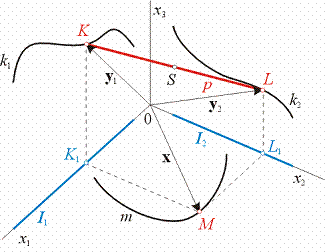
Fig. 1.
Let the curve m be defined by the vector function (2) in the plane x1x2
(2)  ,
,
where for any t![]() I is x(t)
I is x(t)![]() I1, y(t)
I1, y(t)![]() I2 and
I2 and  is a non-zero vector.
is a non-zero vector.
Now, we will construct the generating line p in this way (Fig. 1):
a) We choose a point M on the curve m and mark its orthogonal projections to the axes x1 and x2 as K1 and L1.
b) Points K and L are points located on curves k1 and k2 respectively, while K1 and L1 are their orthogonal projections to the plane x1x2 .
c) Line p = KL.
Line p is a generating line of the ruled surface
 and with this method
we would construct next generating lines of the surface
and with this method
we would construct next generating lines of the surface  .
.
2. Parametric representation of the ruled surface  .
.
We obtain the coordinates of points K and L with the substitution (2) to (1). Then
K=[x(t), 0, F(t)] and L[0, y(t), G(t)],
where F(t) = f(x(t)) and G(t)=g(y(t)) .
Let the generating line p be defined for example by the centre

of the line segment KL and by the direction vector
(3) 
Then the ruled surface  has the following parametric representation
has the following parametric representation
(4) 
Example 1: The Surface of an elliptic movement
The vector functions (1) are
(5) 
where q1 and q2 are non-zero
constants from R , q1 q2.
q2.
Curves k1 and k2 are lines, k1 || x1 and k2 || x2. Let the curve m become a circle defined by the vector function
(6)  .
.
The surface  defined in this way
has the following parametric representation according to equation (4)
defined in this way
has the following parametric representation according to equation (4)
(7) 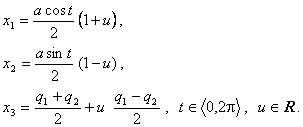
In Fig. 2a are shown curves k1, k2 and m are shown. In Fig. 2b is shown a surface segment, which is called the surface of an elliptic movement is shown.
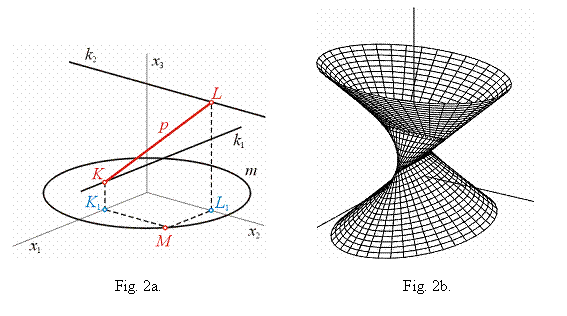 |
|
3. The Section of the surface  by the plane x1x2
by the plane x1x2
If the curve k3 is the section of the surface  by
the plane x1x2 (x3 = 0),
then we get its parametric representation from (4)
by
the plane x1x2 (x3 = 0),
then we get its parametric representation from (4)
(8)  .
.
If for any t ![]() I is
I is
(9) G(t) = F(t),
then the corresponding generating line p || x1x2 and its intersection point with the plane x1x2 is a point at infinity.
The section of the surface  of elliptic movement by the plane x1x2 (from
the example 1 according to (8)) has the following parametric representation
of elliptic movement by the plane x1x2 (from
the example 1 according to (8)) has the following parametric representation
(10)  .
.
This section is the ellipse k3 with the centre in the origin of the coordinate system, values of the semiaxes are
 and
and  .
.
In the case, when the equation (9) expresses identity for the interval I ,
then all generating lines of the surface  are parallel to the plane x1x2
and the section of the surface by the plane x1x2
cannot be described by equations (8).
are parallel to the plane x1x2
and the section of the surface by the plane x1x2
cannot be described by equations (8).
If we choose the vector functions (1) as
(11) 
and the curve m is a line parametrized by the vector function
(12) x(t) = (t,
t, 0) , t ![]() R ,
R ,
then F(t) = G(t) = f(t).
The ruled surface  has
the following parametric representation according to (4):
has
the following parametric representation according to (4):
(13) 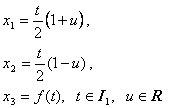
and it is a cylindrical surface. Its generating lines are parallel to the plane x1x2. The curves k1 and k2 are congruent. Revolving the curve k1 about axis x3 by the angle 90° we would get the curve k2 .
The section k3 of the cylindrical surface (13) by the plane x1x2 is composed from the surface generating lines. Their number is equal to the number of common points of the curve k1 and the axis x1 .
Example 2: Circular cylindrical surface
Curves k1 and k2 are semicircles
with centres S1![]() x1
, S2
x1
, S2![]() x2
, with the same radius r and |OS1| = |OS1| = p.
The semicircles are parametrized by the vector functions
x2
, with the same radius r and |OS1| = |OS1| = p.
The semicircles are parametrized by the vector functions

The surface  is a half of the circular cylindrical surface, which has the following parametric
representation according to (13)
is a half of the circular cylindrical surface, which has the following parametric
representation according to (13)
(14) 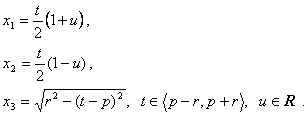
Fig. 3a illustrates curves k1, k2 , m, and the section of the surface by the plane x1x2 which is created by lines l1and l2 . In Fig. 3b the segment of the circular cylindrical surface is shown.
 |
|
4. Developable and skew surfaces 
The generating line of the surface  is defined by choice of the parameter t
is defined by choice of the parameter t ![]() I.
When we substitute the parametric representation (2) of the curve m to
the vector functions (1) and differentiate the vector functions (1) according
to argument t, then we get:
I.
When we substitute the parametric representation (2) of the curve m to
the vector functions (1) and differentiate the vector functions (1) according
to argument t, then we get:

These vector functions for chosen t ![]() I
are defining the direction vectors of tangent lines of curves k1
and k2. To make the generating line of the surface
I
are defining the direction vectors of tangent lines of curves k1
and k2. To make the generating line of the surface  torsal, vectors y1'(t)
, y2'(t) and (3) must be linearly dependent. From this
condition we get equation:
torsal, vectors y1'(t)
, y2'(t) and (3) must be linearly dependent. From this
condition we get equation:
(15)  .
.
If the equation (15) is identity on the interval I,
the surface  is
created by torsal lines only, and it is a developable surface. If the equation
(15) is not identity, the surface
is
created by torsal lines only, and it is a developable surface. If the equation
(15) is not identity, the surface  is a skew surface, on which torsal generating lines can exist.
is a skew surface, on which torsal generating lines can exist.
The equation (15) of the surface of an elliptic movement has the form:
 .
.
Then the lines for parameters t = 0, ![]() /2,
/2,
![]() , 3
, 3![]() /2 are
torsal lines located in the planes x1x3
and x2x3.
/2 are
torsal lines located in the planes x1x3
and x2x3.
In the case, when the cylindrical surface has the parametric presentation (13) we can simply verify that the equation (15) is an identity and the cylindrical surface will be a developable surface. The intersection points K1 and L1 of the line l1 with the semicircles k1 and k2 from the example 2 (Fig. 3a) are examples of points in which derivative of the functions f and g is improper. The tangent lines of the curve k1 and k2 in the points K1 and L1 are parallel with the axis x3. Analogously for the line l2 .
5. Continuity between the surfaces φ and skew surfaces
Continuity between the mentioned ruled surfaces  and skew surfaces, which are defined by three basic curves, is clearly seen
on the surface of an elliptic movement. If the section of the surface
and skew surfaces, which are defined by three basic curves, is clearly seen
on the surface of an elliptic movement. If the section of the surface
 by plane x1x2
is the curve k3, then it is possible to define the surface
by plane x1x2
is the curve k3, then it is possible to define the surface
 by basic curves k1,
k2 and k3. The generating lines of the surface
by basic curves k1,
k2 and k3. The generating lines of the surface
 are lines intersecting the basic
curves.
are lines intersecting the basic
curves.
6. Envelope of orthographic views of the ruled surface generating lines in the plane x1x2
Generating lines of the ruled surface are orthogonally projected to the plane x1x2, and parametric representation of these orthographic views can be given by the first two equations in (4) without the parameter u:
(16)  .
.
The equation (16) is the equation of a one-parametric line system and its envelope can be found by differentiating of the equation (16) according to parameter t:
(17) 
and from the equations (16) and (17) we get:
(18)  .
.
If an envelope exists and it is a curve marked as m’, then the equations (18) are its parametric representation. The points, for which x(t)y'(t)-x'(t)y(t)=0, do not have to be necessarily troublesome points. This problem will be not investigated here.
The envelope m’ depends only on the curve m, what is evident from the equations (18) and the geometric view, too.
If the curve m is a circle parametrized by function (6), then according to (18), the envelope m’ has the parametric representation:
(19) 
the curve m’ is an asteroid (Fig. 4a).
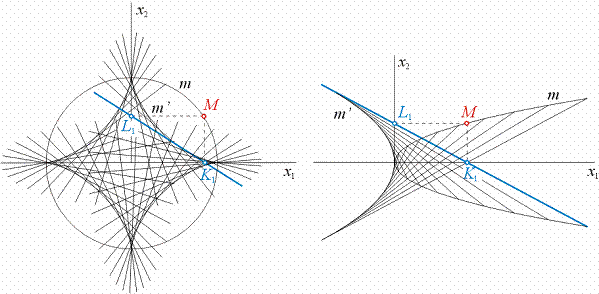 |
|
|
Fig. 4a.
|
Fig. 4b.
|
Orthographic views of the cylindrical surface generating lines (example 2) in the plane x1x2 are examples for the one-parametric system of lines, which has not any envelope.
7. Modification of the method for creation of ruled surfaces
The idea described above allows us to define and create ruled surfaces by
a method, which we could call dual for defining and creating the surfaces
 . The surface is defined by the curves
k1 and k2 , which are parametrized
by functions (1). Let the curve m’ be without singular points in the
plane x1x2 . Tangent lines of the curve
m’ create a one-parametric system of lines.
Let K1 and L1 be intersections of one tangent
line (which is intersecting line with the axes x1 and
x2 too) of the one-parametric system with the axis x1
and x2. We can construct the surface generating line p
by means of points K1 and L1 with the same
method as in the introduction (see Fig. 1).
. The surface is defined by the curves
k1 and k2 , which are parametrized
by functions (1). Let the curve m’ be without singular points in the
plane x1x2 . Tangent lines of the curve
m’ create a one-parametric system of lines.
Let K1 and L1 be intersections of one tangent
line (which is intersecting line with the axes x1 and
x2 too) of the one-parametric system with the axis x1
and x2. We can construct the surface generating line p
by means of points K1 and L1 with the same
method as in the introduction (see Fig. 1).
Example 3: Let the surface  be defined by curves k1 a k2 , which are
parametrized by vector functions (5) and the curve m’
be defined by curves k1 a k2 , which are
parametrized by vector functions (5) and the curve m’ ![]() x1x2
that is a parabola expressed by parametric representation
x1x2
that is a parabola expressed by parametric representation
 .
.
The vector function
(20) 
of parameter v describes the system of tangent lines
to the parabola m’ for any value of parameter t ![]() R
(Fig. 4b).
R
(Fig. 4b).
The intersections of tangent lines with axes x1 and x2 are the points K1 and L1 with the following coordinates
(21)  .
.
The coordinates of the points K and L are
 .
.
The surface parametric representation according to (4) has the following form
(22) 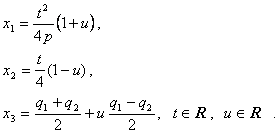
The set of points M, which are projected orthogonally to the points K1 and L1 on the axes x1 and x2 can be parameterized according to (21) by the function

which is the generatrix of the ruled surface  constructed by the method described in the first part.
constructed by the method described in the first part.
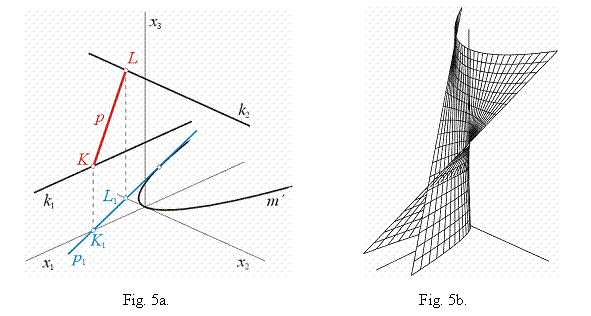 |
|
The both modifications of the presented method are illustrated
in Fig. 4b showing the construction of the surface  projected orthogonally to the plane x1x2,
and in Fig 4a, where the orthogonal projection of the construction of the surface
determined by circle m and asteroid m´ can be seen. Description
of the surface
projected orthogonally to the plane x1x2,
and in Fig 4a, where the orthogonal projection of the construction of the surface
determined by circle m and asteroid m´ can be seen. Description
of the surface  construction is
shown in Fig.5a. A segment of the surface is shown in Fig. 5b.
construction is
shown in Fig.5a. A segment of the surface is shown in Fig. 5b.
The section of the surface  by the plane x1x2 has the following parametric
representation according to (8)
by the plane x1x2 has the following parametric
representation according to (8)
 ,
,
the curve k3 is parabola.
The equation (15) has the form
 ,
,
and therefore the surface has only one torsal basic line correspondent to the parameter t = 0.
Now we will show some examples of the surfaces  .
.
Example 4: Conical surface
The vector functions (1) are

The curve k1 is a line, the curve k2 is a parabola. Let the curve m be a line parallel to the axis x2 , which is defined by the vector function
(23) x(t) = (k, t, 0), t ![]() R,
k is a nonzero constant from R (Fig. 6a).
R,
k is a nonzero constant from R (Fig. 6a).
The surface  has the
following parametric representation according to (4)
has the
following parametric representation according to (4)
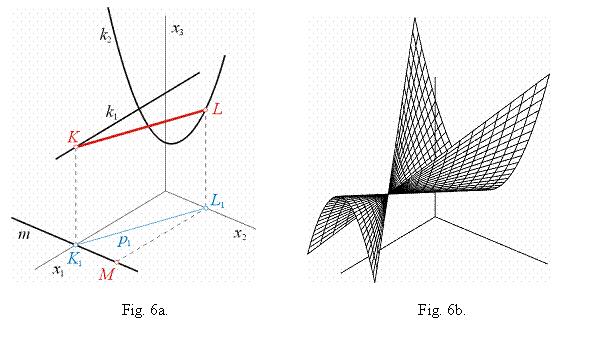 |
|
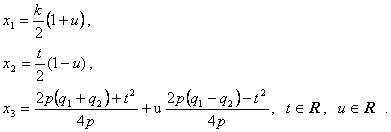
It is evident that the surface  is a conical surface with a vertex in the point K, so this surface is
developable. In this case the equation (15) is an identity, because in the vector
function (23) is x'(t) = 0 for all t
is a conical surface with a vertex in the point K, so this surface is
developable. In this case the equation (15) is an identity, because in the vector
function (23) is x'(t) = 0 for all t ![]() R.
The segment of the surface is illustrated in Fig. 6b.
R.
The segment of the surface is illustrated in Fig. 6b.
We could construct generating lines by means of a one-parametric system of lines in the plane x1x2, too. In this case, the system of lines would be a pencil of lines with the centre in the point K1 (without the line m). The line p1 is one line from the pencil of lines (see Fig.6a). This is nothing new for us, it is a classical construction of conical surface generating lines.
Example 5: Frezier’s cylindroid
The vector functions (1) are

The curves k1 and k2 are semicircles as in the example 2 for the cylindrical surface, but the circle k2 is translated by the translation vector (0, 0, q). The curve m is a line defined by the vector function (12), Fig. 7a.
This surface is so called Frezier’s cylindroid and its segment is shown in Fig.7b. The surface is a skew surface, which has two torsal generating lines. The equation (15) has the form

and this is fulfilled only for the points ![]() , in which derivative of the functions f and g is improper.
Orthographic views of torsal lines in the plane x1x2
are the lines l1 and l2 (Fig. 7a).
, in which derivative of the functions f and g is improper.
Orthographic views of torsal lines in the plane x1x2
are the lines l1 and l2 (Fig. 7a).
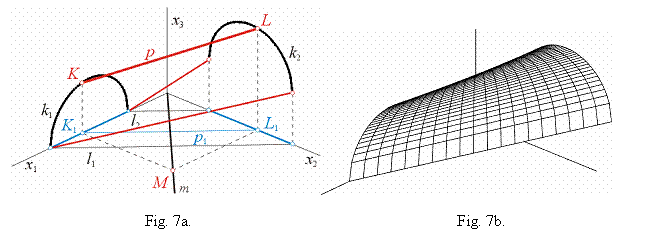 |
|
It is possible to construct cylindroid generating lines analogously using the one-parametric system of lines as at a conical surface. It this case the system of lines is parallel to the line l1.
At the end of this paper there are illustrated two complicated surfaces (see Figs 8 and 9).
The segment of the surface demonstrated in Fig. 8 is defined by curves k1, k2 and m, where the curve k1 is Witch of Agnési, k2 is a parabola and the curve m is an epicycloid. In Fig. 9 is a segment of the surface for which the curve k1 is Witch of Agnési, the curve k2 is a parabola and the curve m is a circle with its centre in the origin.
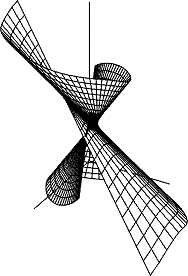 |
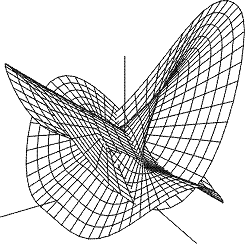 |
|
Fig. 8.
|
Fig. 9.
|
|
|
|
|
RNDr. Kamil Maleček Department of Mathematics Civil Engineering Faculty Thákurova 7, 166 29 Praha 6,
tel: +4202 2435 4384 e-mail: kamil@mat.fsv.cvut.cz |
RNDr. Dagmar Szarková Department of Mathematics Mechanical Engineering Faculty Slovak Technical University Námestie Slobody 17, 812 31 Bratislava, Slovakia tel: +4217 57296 394, fax: +4217 52926626 e-mail: szarkova@sjf.stuba.sk |